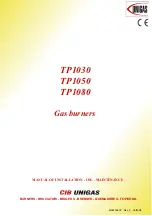
CIB UNIGAS - M039168CC
13
Fitting the burner to the boiler
1
To perform the installation, it is necessary to drill the boiler door as described on paragraph “Overall dimensions”;
2
screw the studbolts (5) on the boiler door, according to the drilling plate (see paragraph “Overall dimensions”);
3
move the burner towards the boiler: lift the burner by means of the eyebolts placed on its top side;
4
place the flange to the boiler and a gasket between them;
5
fit the glass fibre plait;
6
replace the blast tube: before fastening completely the screws, avoid any misalignement between the blast tube axis and the com-
bustion head axis;
7
install the burner to the boiler;
8
fix the burner to the stud bolts, by means of the fixing nuts, according to Fig. 4.
9
After fitting the burner to the boiler, ensure that the gap between the blast tube and the refractory lining is sealed with appropriate
insulating material (ceramic fibre cord or refractory cement).
Fan installation
Pay attention when designing the air duct: dimensioning must be performed according to the flow rate, the temperature, the distance
between the fan and the burner and according to the fan features as well.
Matching the burner to the boiler
To correctly match the burner to the boiler verify the necessary input and the pressure in combustion chamber are included in the bur-
ner performance curve; otherwise the choice of the burner must be revised consulting the burner manufacturer.
To choose the blast tube lenght follow the instructions of the boiler manufacturer. In absence of these consider the following:
z
Cast-iron boilers, three pass flue boilers (with the first pass in the rear part): the blast tube must protrude no more than 100 mm into
the combustion chamber.
z
Pressurised boilers with flame reversal: in this case the blast tube must penetrate at least 50 - 100 mm into combustion chamber in
respect to the tube bundle plate.
The length of the blast tubes does not always allow this requirement to be met, and thus it may be necessary to use a suitably-sized
spacer to move the burner backwards.
Fig. 4
Keys
1
Burner
2
Fixing nut
3
Washer
4
Gasket
5
Stud bolt
7
Blast tube
ATTENTION!
The bellows unit provided is made of canvas and is provided with blocking spacers to avoid breaking it during
installation:
first
place the bellows unit between flanges,
then
remove the spacers. Canvas has to be stretched after the instal-
lation, but not stressed.
4
7














































